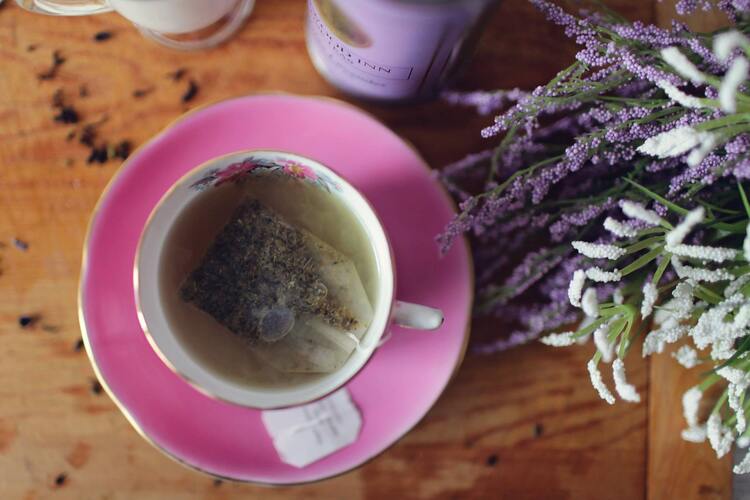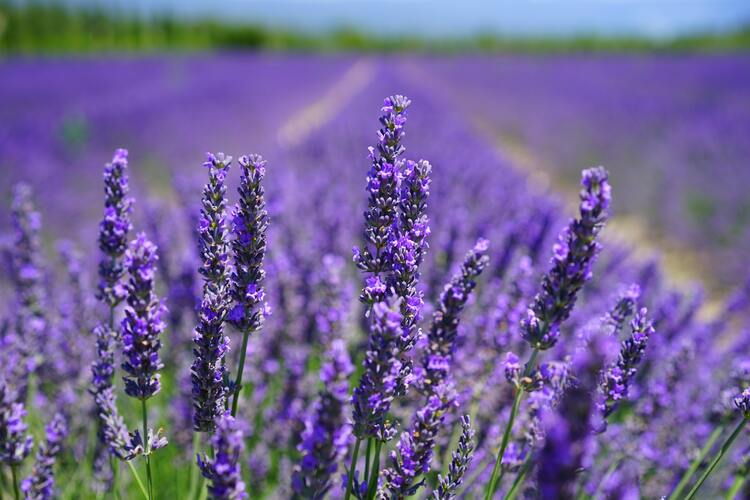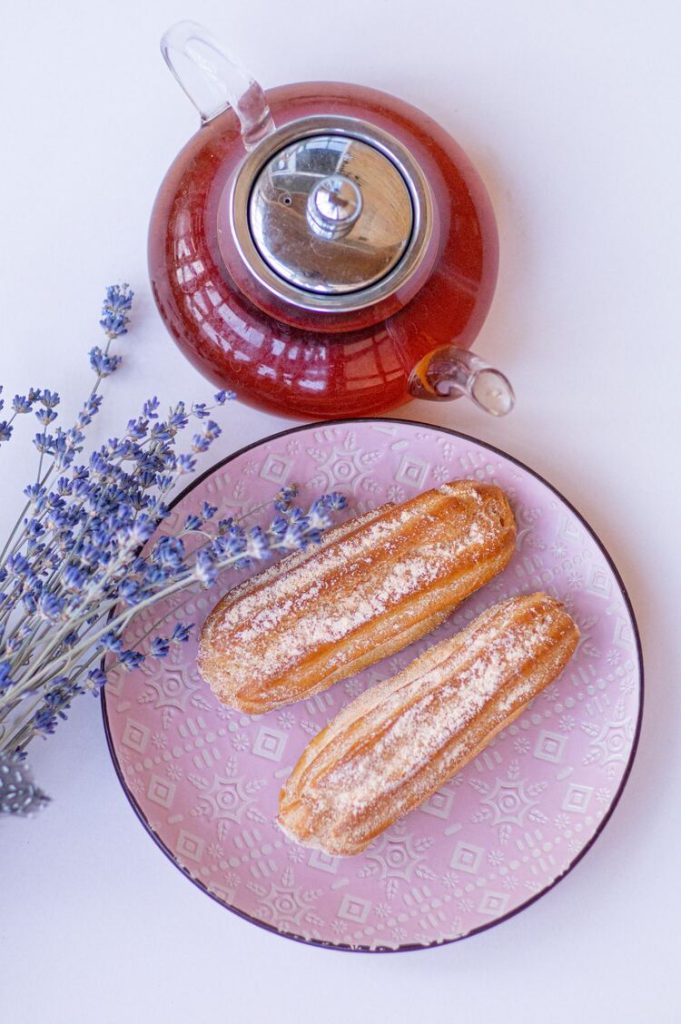What does lavender tea taste like? Lavender is a popular herb known for its soothing properties. It is often used in aromatherapy and beauty products, but did you know that it can also be brewed into a delicious tea?
Lavender tea has a taste that is both floral and herbaceous. The flavor is often described as delicate, slightly sweet, and with a subtle hint of mint. Some people also detect a slightly bitter aftertaste. The aroma of lavender tea is just as pleasant as the taste, with a calming and relaxing scent that can help reduce stress and anxiety. It can be enjoyed hot or cold and sweetened with honey or sugar if desired.
If you haven’t tried lavender tea yet, keep reading since after learning more about it, I am sure you will want to try it.
Please note: This article contains affiliate links, meaning I may earn a commission if you make a purchase by clicking a link. Of course, this comes at no extra cost to you and helps me keep offering readers solid information.

What is Lavender Tea?
If you’re curious about what lavender tea tastes like, it’s important first to understand what it is. Lavender tea is a herbal tea made from dried lavender flowers or buds. Lavender is a species of flowering plant that is native to Europe and is known for its beautiful and fragrant purple flowers.
Lavender tea is made by steeping dried lavender flowers or buds in hot water. It is often combined with other herbs, such as mint, to create a more complex flavor profile. Some people also enjoy adding honey or lemon to their lavender tea to enhance the flavor.
It’s important to note that not all lavender is edible or suitable for making tea. It’s best to use organic, food-grade lavender specifically labeled for culinary use when making lavender tea. This ensures that the lavender is free from harmful chemicals and pesticides.
What Does Lavender Tea Taste Like?
When it comes to lavender tea, the taste can be quite unique. Here’s what you can expect when you take a sip:
- Floral: Lavender tea is renowned for its prominent floral notes. The flavor is reminiscent of the sweet, fragrant blossoms of the lavender plant. The floral aspect is often described as subtle and distinct, making it a delightful choice for those who appreciate floral teas.
- Herbaceous: This tea has a mild herbaceous quality due to the lavender plant’s natural herbal characteristics. This herbal undertone provides a pleasant complexity to the tea’s flavor.
- Sweetness: Lavender tea can have a natural sweetness to it, especially when brewed with dried lavender flowers. This sweetness is gentle and not overpowering, contributing to the overall pleasantness of the tea.
- Subtle Citrus Notes: Some lavender varieties may have subtle citrus undertones, adding a hint of brightness to the flavor. This citrusy aspect can vary depending on the lavender species and growing conditions.
- Earthiness: This tea may also have a subtle earthy or grassy undertone, which balances the sweetness and floral notes, providing a well-rounded taste.
- Light and Refreshing: Lavender tea is typically light in body and refreshing, making it an excellent choice for relaxation and unwinding.
When brewed correctly, lavender tea offers a calming and soothing experience in terms of flavor and aroma. It is often enjoyed plain but can also be enhanced with a touch of honey or lemon if desired. Lavender tea is popular for those seeking a gentle and aromatic herbal infusion that promotes relaxation and tranquility.

How to Make Lavender Tea
Making lavender tea is a simple process that requires only a few ingredients. Here’s how you can make your own tea at home:
- Boil water: Start by boiling water in a pot or kettle. You’ll need about 2 cups of water for every 1 tablespoon of dried lavender buds.
- Add lavender buds: Once the water has boiled, add 1 tablespoon of dried lavender buds to the pot or kettle. You can also use fresh lavender flowers if you have them.
- Steep: Cover the pot or kettle and let the lavender buds steep for 5-10 minutes. The longer you steep the tea, the stronger the lavender flavor will be.
- Strain: After steeping, strain the tea using a fine mesh strainer or cheesecloth to remove the lavender buds.
- Add sweetener: If you prefer sweet tea, you can add honey or sugar to taste. Lavender tea also pairs well with a splash of milk or a squeeze of lemon for added flavor.
- Enjoy: Pour your lavender tea into a cup and enjoy! You can also chill the tea in the refrigerator and serve it over ice for a refreshing summer drink.
As you can see, making lavender tea is a simple and enjoyable process that can be customized to your taste preferences. Try it and see how this soothing tea can help you relax and unwind.
Lavender Tea Varieties
When it comes to lavender tea, there are a few different varieties. Here are some of the most popular ones:
- English Lavender Tea: Made from the flowers of the English lavender plant, this tea has a delicate floral flavor with a slightly sweet finish. It is often used as a natural remedy for anxiety and insomnia.
- French Lavender Tea: This tea is made from the flowers of the French lavender plant and has a slightly stronger flavor than English lavender tea. It has a slightly sweet, herbaceous taste and is often used as a natural remedy for headaches and digestive issues.
- Spanish Lavender Tea: Made from the flowers of the Spanish lavender plant, this tea has a strong, pungent flavor with a slightly bitter aftertaste. It is often used as a natural remedy for respiratory issues and a digestive aid.
- Lavender Earl Grey Tea: This tea blends black tea and lavender flowers with a hint of bergamot. It has a bold, rich flavor with a subtle floral note.
- Lavender Chamomile Tea: A blend of chamomile flowers and lavender, this tea has a gentle, soothing flavor that is perfect for relaxation and stress relief.

Lavender Tea Food Pairings
Lavender tea has a unique flavor that is both floral and slightly sweet. It pairs well with a variety of foods, from sweet to savory. Here are some ideas for food pairings that will complement the taste of lavender tea:
- Sweet Treats: Lavender tea goes well with sweet treats like shortbread cookies, scones, and macarons. The floral notes in the tea complement the buttery, crumbly texture of these treats. You can also pair lavender tea with fruit tarts or cakes with a light, fluffy texture.
- Savory Dishes: Lavender tea can also be paired with savory dishes. It goes well with light and fresh salads and roasted or grilled meats like chicken or pork. You can pair lavender tea with light pasta dishes like spaghetti aglio e olio or creamy risottos.
- Cheeses: Lavender tea pairs well with various cheeses, including goat cheese, brie, and camembert. The floral notes in the tea complement the creamy texture of these cheeses, creating a delicious combination of flavors.
- Herbs and Spices: Lavender tea can also be paired with herbs and spices like thyme, rosemary, and cinnamon. These spices bring out the floral notes in the tea, creating a complex and delicious flavor.
- Chocolate: Lavender tea pairs well with dark chocolate. The floral notes in the tea complement the rich, slightly bitter flavor of the chocolate, creating a delicious combination of flavors.
Overall, lavender tea is a versatile drink that can be paired with various foods. Whether you prefer sweet or savory dishes, there is a food pairing that will complement the unique flavor of lavender tea.

Benefits of Lavender Tea
Lavender tea is not only delicious, but it also offers a range of health benefits. Here are some of the benefits you can get from drinking lavender tea:
Antioxidants
Lavender tea is rich in antioxidants, which can help protect your body from harmful free radicals. These antioxidants can help reduce your risk of developing chronic diseases like cancer, heart disease, and diabetes.
Calming Effects
Lavender tea is known for its calming effects. It can help reduce anxiety and promote relaxation. Drinking lavender tea before bed can help improve your sleep quality and reduce insomnia.
Stress
Lavender tea can help reduce stress levels and promote relaxation. It can help reduce cortisol levels, which is the hormone that is released in response to stress.
Inflammation
Lavender tea has anti-inflammatory properties that can help reduce inflammation in the body. It can help reduce pain and swelling associated with arthritis and other inflammatory diseases.
Incorporating lavender tea into your daily routine can help improve your overall health and well-being.

Recipes with Lavender Tea
If you’re looking to experiment with lavender tea in your cooking, plenty of recipes out there incorporate the floral flavor of this tea. Here are a few ideas to get you started:
Lavender Milk Tea
To make a simple lavender milk tea, brew a cup of lavender tea and add a splash of milk. You can also add a sweetener like honey or sugar to taste. This is a great option if you’re looking for a soothing and comforting drink before bed.
Lavender Cookies
Lavender can add a unique and subtle flavor to cookies. To make lavender cookies, add a tablespoon of dried lavender flowers to your favorite sugar cookie recipe. You can also use lavender extract or lavender sugar for an even stronger lavender flavor.
Lavender Desserts
Lavender can also be used in various desserts, from cakes to ice cream. Here are a few ideas:
- Lavender Honey Cake: Add a tablespoon of dried lavender flowers to your favorite honey cake recipe for a unique twist on a classic dessert.
- Lavender Ice Cream: Infuse cream with lavender by heating it gently with dried lavender flowers, then use it to make homemade ice cream.
- Lavender Shortbread: Add a tablespoon of dried lavender flowers to your favorite shortbread recipe for a delicate and delicious cookie.
Lavender Beverages
Lavender can also be used to flavor a variety of beverages, from cocktails to lemonade. Here are a few ideas:
- Lavender Lemonade: Add a few drops of lavender extract or a tablespoon of dried lavender flowers to your favorite lemonade recipe for a refreshing and unique twist.
- Lavender Cocktail: Use lavender syrup or lavender-infused gin to make a delicious and fragrant cocktail. Add a sprig of fresh lavender for garnish.
Overall, lavender tea can be a versatile and interesting ingredient to experiment with in cooking and baking. Just be sure to use it sparingly; a little goes a long way regarding this floral flavor.
Buying Recommendations
Hope I have convinced you to try lavender tea. If so, here are some recommendations for preparing this beverage at home.
Buddha Teas Organic Lavender Tea

Organic Lavender Flowers Dried

The Republic of Tea Beautifying Botanicals® Daily Beauty Blueberry Lavender Herbal Tea

Traditional Medicinals Organic Chamomile with Lavender Tea

BLUE TEA – Chamomile Lavender Tea

Well, my friends, this is it for now. Hope you have enjoyed the article. What are your thoughts about using lavender in food and drinks?
To you, what does lavender tea taste like?
More About Floral Teas
What Does Jasmine Tea Taste Like?
What Does Hibiscus Tea Taste Like?
What Does Rose Tea Taste Like?
What Does Chrysanthemum Tea Taste Like?
What Does Mullein Tea Taste Like?
What Does Red Clover Tea Taste Like?
What Does Osmanthus Tea Taste Like?